Importance of Primary Health strategy in Improving Health Condition.
VerifiedAdded on 2022/08/13
|8
|1920
|22
AI Summary
Contribute Materials
Your contribution can guide someone’s learning journey. Share your
documents today.
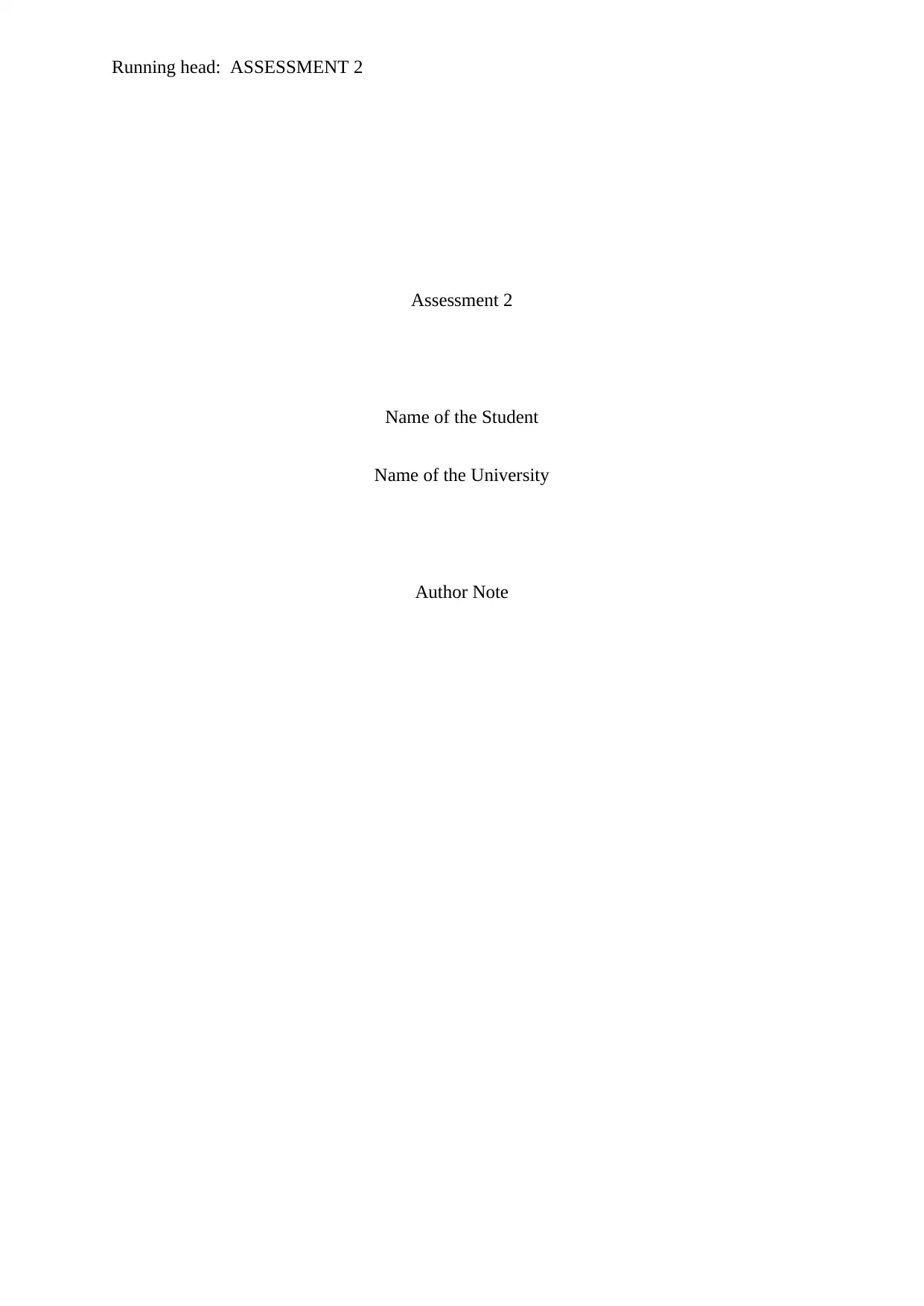
Running head: ASSESSMENT 2
Assessment 2
Name of the Student
Name of the University
Author Note
Assessment 2
Name of the Student
Name of the University
Author Note
Secure Best Marks with AI Grader
Need help grading? Try our AI Grader for instant feedback on your assignments.
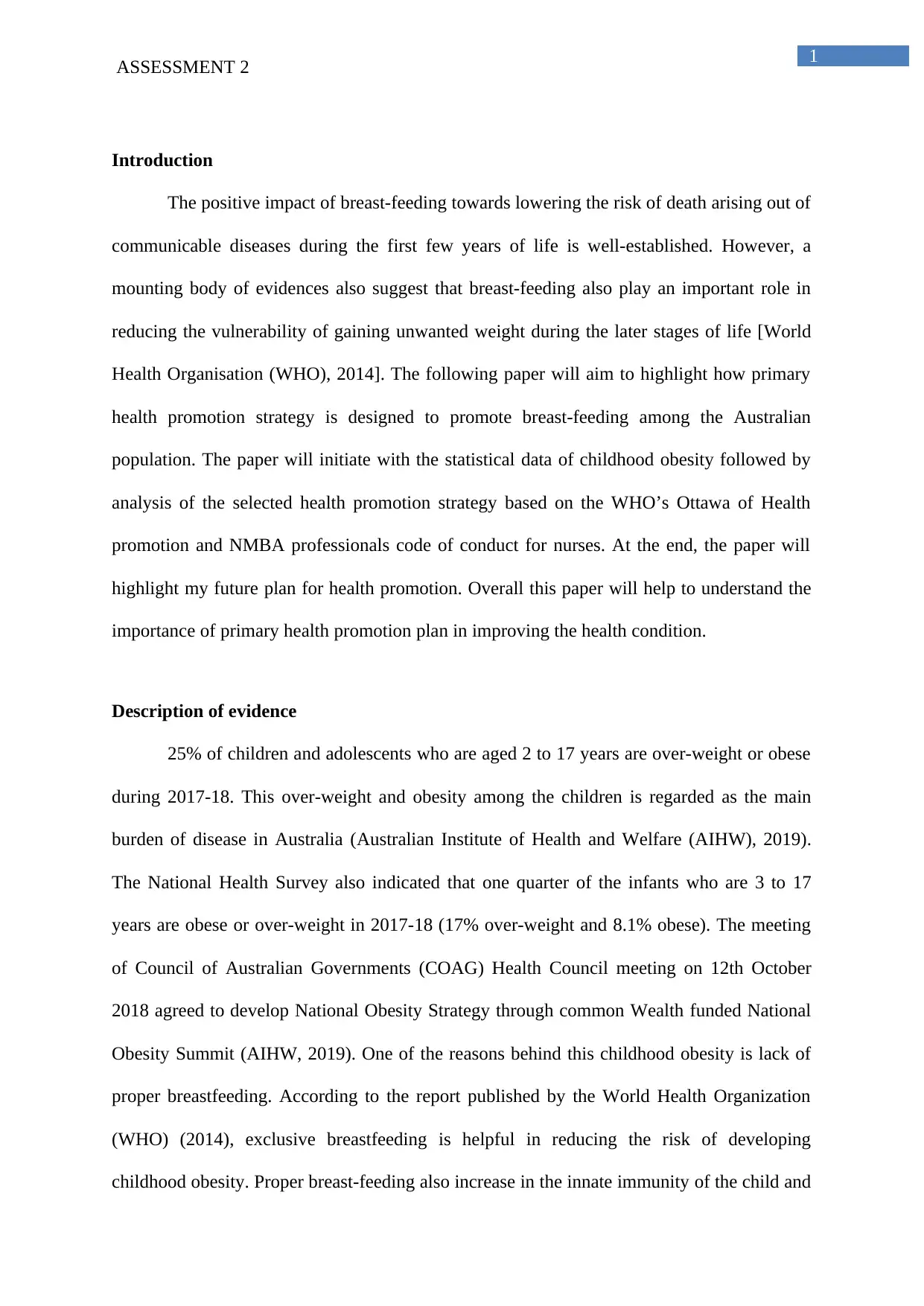
1
ASSESSMENT 2
Introduction
The positive impact of breast-feeding towards lowering the risk of death arising out of
communicable diseases during the first few years of life is well-established. However, a
mounting body of evidences also suggest that breast-feeding also play an important role in
reducing the vulnerability of gaining unwanted weight during the later stages of life [World
Health Organisation (WHO), 2014]. The following paper will aim to highlight how primary
health promotion strategy is designed to promote breast-feeding among the Australian
population. The paper will initiate with the statistical data of childhood obesity followed by
analysis of the selected health promotion strategy based on the WHO’s Ottawa of Health
promotion and NMBA professionals code of conduct for nurses. At the end, the paper will
highlight my future plan for health promotion. Overall this paper will help to understand the
importance of primary health promotion plan in improving the health condition.
Description of evidence
25% of children and adolescents who are aged 2 to 17 years are over-weight or obese
during 2017-18. This over-weight and obesity among the children is regarded as the main
burden of disease in Australia (Australian Institute of Health and Welfare (AIHW), 2019).
The National Health Survey also indicated that one quarter of the infants who are 3 to 17
years are obese or over-weight in 2017-18 (17% over-weight and 8.1% obese). The meeting
of Council of Australian Governments (COAG) Health Council meeting on 12th October
2018 agreed to develop National Obesity Strategy through common Wealth funded National
Obesity Summit (AIHW, 2019). One of the reasons behind this childhood obesity is lack of
proper breastfeeding. According to the report published by the World Health Organization
(WHO) (2014), exclusive breastfeeding is helpful in reducing the risk of developing
childhood obesity. Proper breast-feeding also increase in the innate immunity of the child and
ASSESSMENT 2
Introduction
The positive impact of breast-feeding towards lowering the risk of death arising out of
communicable diseases during the first few years of life is well-established. However, a
mounting body of evidences also suggest that breast-feeding also play an important role in
reducing the vulnerability of gaining unwanted weight during the later stages of life [World
Health Organisation (WHO), 2014]. The following paper will aim to highlight how primary
health promotion strategy is designed to promote breast-feeding among the Australian
population. The paper will initiate with the statistical data of childhood obesity followed by
analysis of the selected health promotion strategy based on the WHO’s Ottawa of Health
promotion and NMBA professionals code of conduct for nurses. At the end, the paper will
highlight my future plan for health promotion. Overall this paper will help to understand the
importance of primary health promotion plan in improving the health condition.
Description of evidence
25% of children and adolescents who are aged 2 to 17 years are over-weight or obese
during 2017-18. This over-weight and obesity among the children is regarded as the main
burden of disease in Australia (Australian Institute of Health and Welfare (AIHW), 2019).
The National Health Survey also indicated that one quarter of the infants who are 3 to 17
years are obese or over-weight in 2017-18 (17% over-weight and 8.1% obese). The meeting
of Council of Australian Governments (COAG) Health Council meeting on 12th October
2018 agreed to develop National Obesity Strategy through common Wealth funded National
Obesity Summit (AIHW, 2019). One of the reasons behind this childhood obesity is lack of
proper breastfeeding. According to the report published by the World Health Organization
(WHO) (2014), exclusive breastfeeding is helpful in reducing the risk of developing
childhood obesity. Proper breast-feeding also increase in the innate immunity of the child and
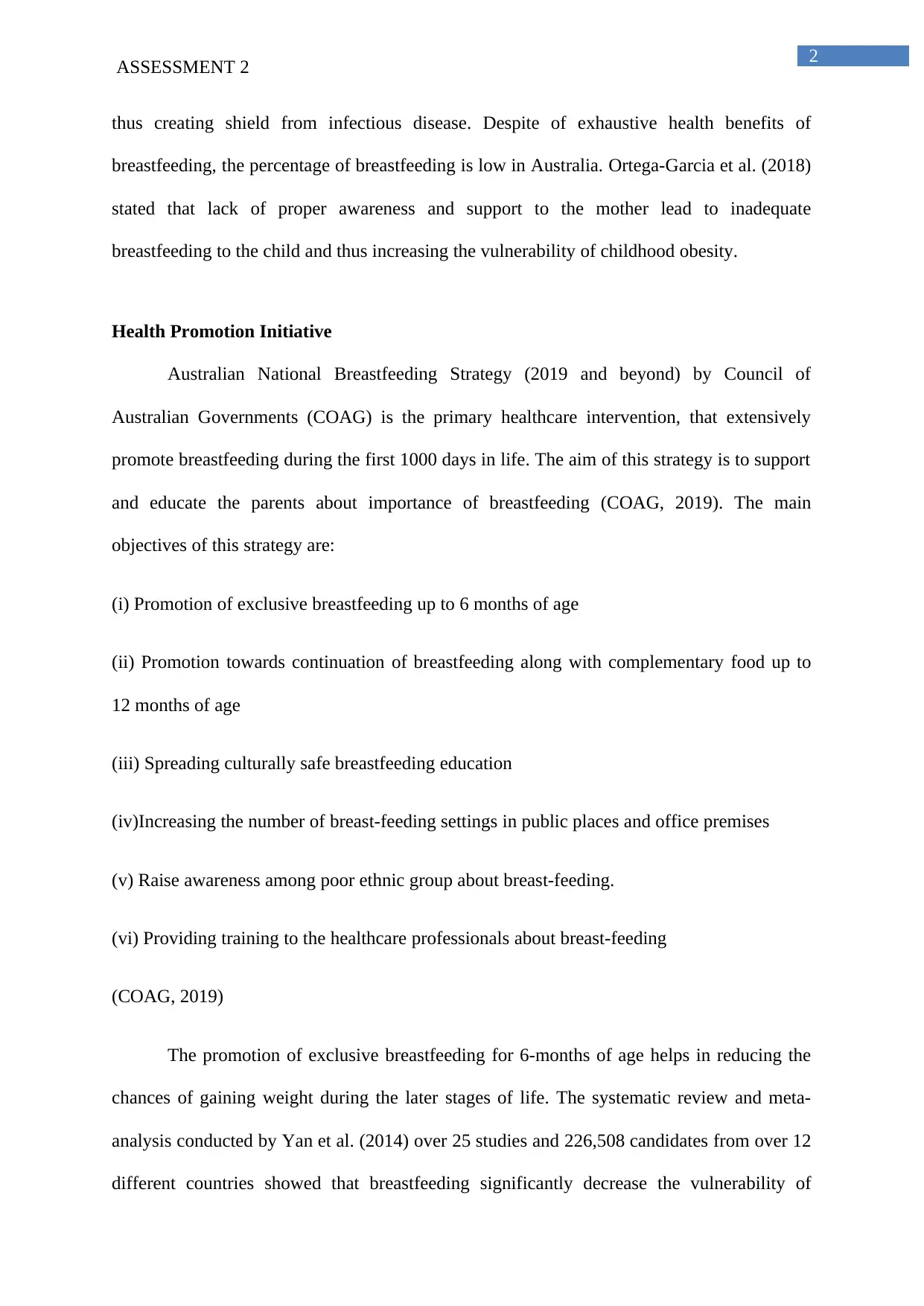
2
ASSESSMENT 2
thus creating shield from infectious disease. Despite of exhaustive health benefits of
breastfeeding, the percentage of breastfeeding is low in Australia. Ortega-Garcia et al. (2018)
stated that lack of proper awareness and support to the mother lead to inadequate
breastfeeding to the child and thus increasing the vulnerability of childhood obesity.
Health Promotion Initiative
Australian National Breastfeeding Strategy (2019 and beyond) by Council of
Australian Governments (COAG) is the primary healthcare intervention, that extensively
promote breastfeeding during the first 1000 days in life. The aim of this strategy is to support
and educate the parents about importance of breastfeeding (COAG, 2019). The main
objectives of this strategy are:
(i) Promotion of exclusive breastfeeding up to 6 months of age
(ii) Promotion towards continuation of breastfeeding along with complementary food up to
12 months of age
(iii) Spreading culturally safe breastfeeding education
(iv)Increasing the number of breast-feeding settings in public places and office premises
(v) Raise awareness among poor ethnic group about breast-feeding.
(vi) Providing training to the healthcare professionals about breast-feeding
(COAG, 2019)
The promotion of exclusive breastfeeding for 6-months of age helps in reducing the
chances of gaining weight during the later stages of life. The systematic review and meta-
analysis conducted by Yan et al. (2014) over 25 studies and 226,508 candidates from over 12
different countries showed that breastfeeding significantly decrease the vulnerability of
ASSESSMENT 2
thus creating shield from infectious disease. Despite of exhaustive health benefits of
breastfeeding, the percentage of breastfeeding is low in Australia. Ortega-Garcia et al. (2018)
stated that lack of proper awareness and support to the mother lead to inadequate
breastfeeding to the child and thus increasing the vulnerability of childhood obesity.
Health Promotion Initiative
Australian National Breastfeeding Strategy (2019 and beyond) by Council of
Australian Governments (COAG) is the primary healthcare intervention, that extensively
promote breastfeeding during the first 1000 days in life. The aim of this strategy is to support
and educate the parents about importance of breastfeeding (COAG, 2019). The main
objectives of this strategy are:
(i) Promotion of exclusive breastfeeding up to 6 months of age
(ii) Promotion towards continuation of breastfeeding along with complementary food up to
12 months of age
(iii) Spreading culturally safe breastfeeding education
(iv)Increasing the number of breast-feeding settings in public places and office premises
(v) Raise awareness among poor ethnic group about breast-feeding.
(vi) Providing training to the healthcare professionals about breast-feeding
(COAG, 2019)
The promotion of exclusive breastfeeding for 6-months of age helps in reducing the
chances of gaining weight during the later stages of life. The systematic review and meta-
analysis conducted by Yan et al. (2014) over 25 studies and 226,508 candidates from over 12
different countries showed that breastfeeding significantly decrease the vulnerability of
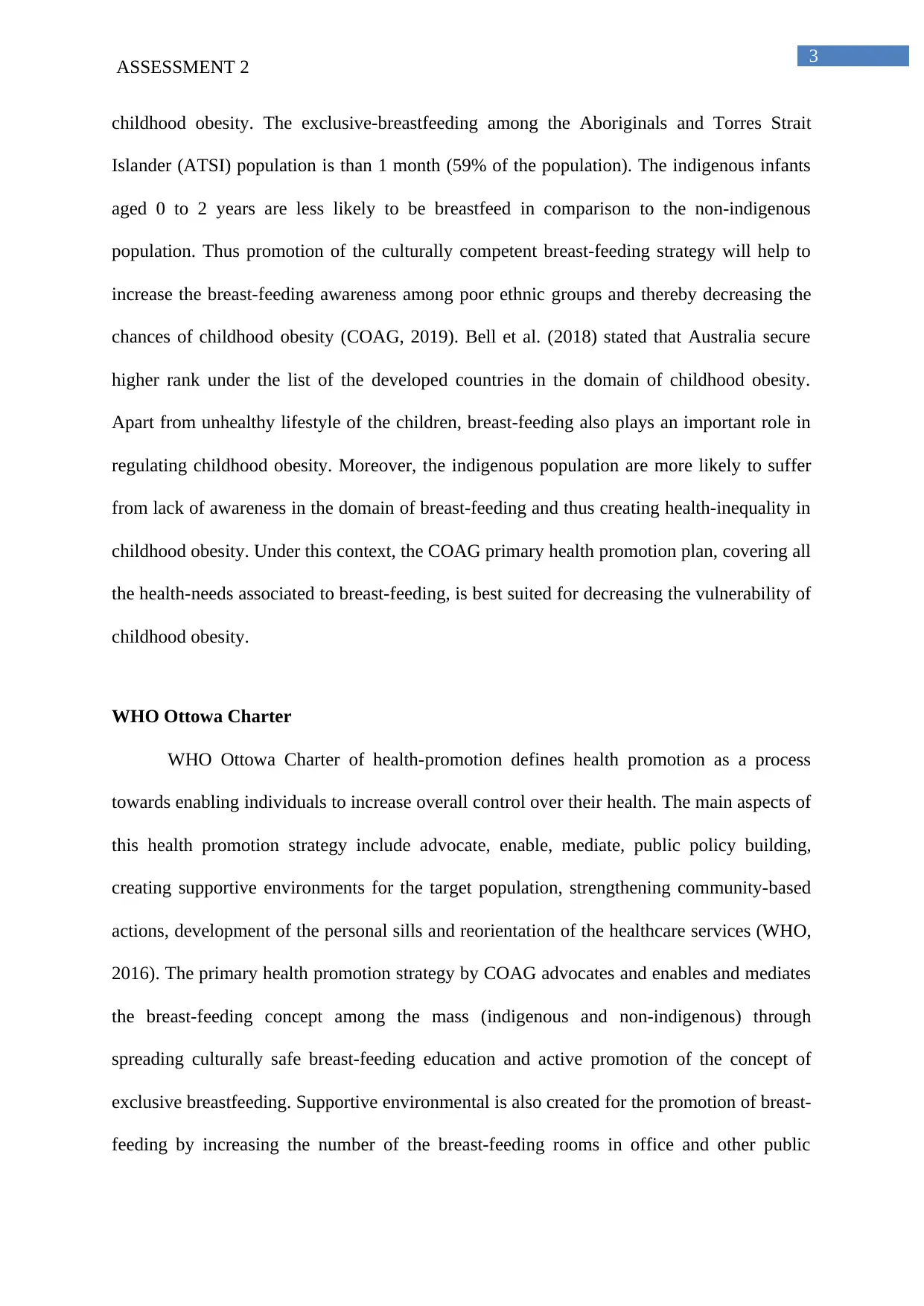
3
ASSESSMENT 2
childhood obesity. The exclusive-breastfeeding among the Aboriginals and Torres Strait
Islander (ATSI) population is than 1 month (59% of the population). The indigenous infants
aged 0 to 2 years are less likely to be breastfeed in comparison to the non-indigenous
population. Thus promotion of the culturally competent breast-feeding strategy will help to
increase the breast-feeding awareness among poor ethnic groups and thereby decreasing the
chances of childhood obesity (COAG, 2019). Bell et al. (2018) stated that Australia secure
higher rank under the list of the developed countries in the domain of childhood obesity.
Apart from unhealthy lifestyle of the children, breast-feeding also plays an important role in
regulating childhood obesity. Moreover, the indigenous population are more likely to suffer
from lack of awareness in the domain of breast-feeding and thus creating health-inequality in
childhood obesity. Under this context, the COAG primary health promotion plan, covering all
the health-needs associated to breast-feeding, is best suited for decreasing the vulnerability of
childhood obesity.
WHO Ottowa Charter
WHO Ottowa Charter of health-promotion defines health promotion as a process
towards enabling individuals to increase overall control over their health. The main aspects of
this health promotion strategy include advocate, enable, mediate, public policy building,
creating supportive environments for the target population, strengthening community-based
actions, development of the personal sills and reorientation of the healthcare services (WHO,
2016). The primary health promotion strategy by COAG advocates and enables and mediates
the breast-feeding concept among the mass (indigenous and non-indigenous) through
spreading culturally safe breast-feeding education and active promotion of the concept of
exclusive breastfeeding. Supportive environmental is also created for the promotion of breast-
feeding by increasing the number of the breast-feeding rooms in office and other public
ASSESSMENT 2
childhood obesity. The exclusive-breastfeeding among the Aboriginals and Torres Strait
Islander (ATSI) population is than 1 month (59% of the population). The indigenous infants
aged 0 to 2 years are less likely to be breastfeed in comparison to the non-indigenous
population. Thus promotion of the culturally competent breast-feeding strategy will help to
increase the breast-feeding awareness among poor ethnic groups and thereby decreasing the
chances of childhood obesity (COAG, 2019). Bell et al. (2018) stated that Australia secure
higher rank under the list of the developed countries in the domain of childhood obesity.
Apart from unhealthy lifestyle of the children, breast-feeding also plays an important role in
regulating childhood obesity. Moreover, the indigenous population are more likely to suffer
from lack of awareness in the domain of breast-feeding and thus creating health-inequality in
childhood obesity. Under this context, the COAG primary health promotion plan, covering all
the health-needs associated to breast-feeding, is best suited for decreasing the vulnerability of
childhood obesity.
WHO Ottowa Charter
WHO Ottowa Charter of health-promotion defines health promotion as a process
towards enabling individuals to increase overall control over their health. The main aspects of
this health promotion strategy include advocate, enable, mediate, public policy building,
creating supportive environments for the target population, strengthening community-based
actions, development of the personal sills and reorientation of the healthcare services (WHO,
2016). The primary health promotion strategy by COAG advocates and enables and mediates
the breast-feeding concept among the mass (indigenous and non-indigenous) through
spreading culturally safe breast-feeding education and active promotion of the concept of
exclusive breastfeeding. Supportive environmental is also created for the promotion of breast-
feeding by increasing the number of the breast-feeding rooms in office and other public
Secure Best Marks with AI Grader
Need help grading? Try our AI Grader for instant feedback on your assignments.
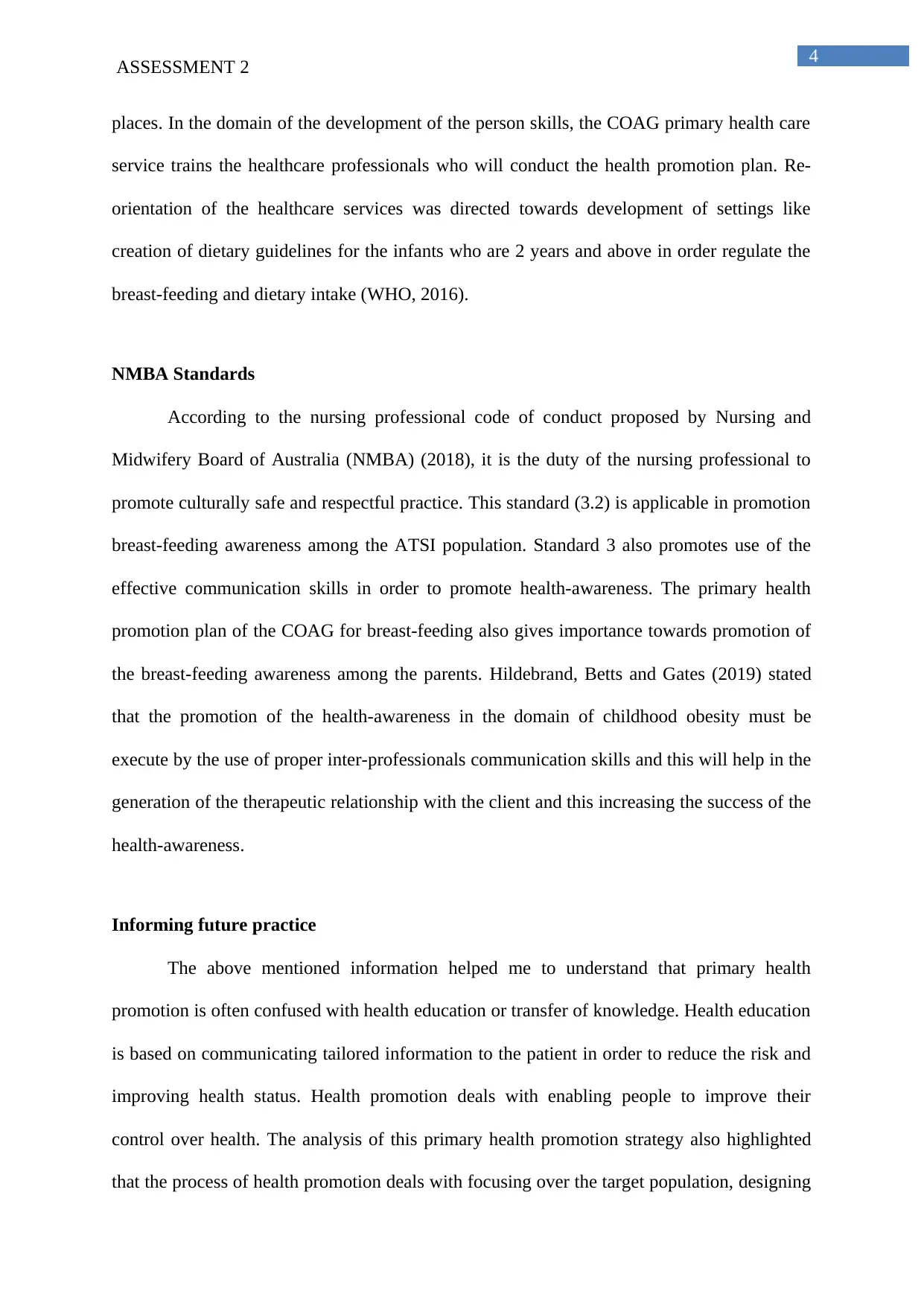
4
ASSESSMENT 2
places. In the domain of the development of the person skills, the COAG primary health care
service trains the healthcare professionals who will conduct the health promotion plan. Re-
orientation of the healthcare services was directed towards development of settings like
creation of dietary guidelines for the infants who are 2 years and above in order regulate the
breast-feeding and dietary intake (WHO, 2016).
NMBA Standards
According to the nursing professional code of conduct proposed by Nursing and
Midwifery Board of Australia (NMBA) (2018), it is the duty of the nursing professional to
promote culturally safe and respectful practice. This standard (3.2) is applicable in promotion
breast-feeding awareness among the ATSI population. Standard 3 also promotes use of the
effective communication skills in order to promote health-awareness. The primary health
promotion plan of the COAG for breast-feeding also gives importance towards promotion of
the breast-feeding awareness among the parents. Hildebrand, Betts and Gates (2019) stated
that the promotion of the health-awareness in the domain of childhood obesity must be
execute by the use of proper inter-professionals communication skills and this will help in the
generation of the therapeutic relationship with the client and this increasing the success of the
health-awareness.
Informing future practice
The above mentioned information helped me to understand that primary health
promotion is often confused with health education or transfer of knowledge. Health education
is based on communicating tailored information to the patient in order to reduce the risk and
improving health status. Health promotion deals with enabling people to improve their
control over health. The analysis of this primary health promotion strategy also highlighted
that the process of health promotion deals with focusing over the target population, designing
ASSESSMENT 2
places. In the domain of the development of the person skills, the COAG primary health care
service trains the healthcare professionals who will conduct the health promotion plan. Re-
orientation of the healthcare services was directed towards development of settings like
creation of dietary guidelines for the infants who are 2 years and above in order regulate the
breast-feeding and dietary intake (WHO, 2016).
NMBA Standards
According to the nursing professional code of conduct proposed by Nursing and
Midwifery Board of Australia (NMBA) (2018), it is the duty of the nursing professional to
promote culturally safe and respectful practice. This standard (3.2) is applicable in promotion
breast-feeding awareness among the ATSI population. Standard 3 also promotes use of the
effective communication skills in order to promote health-awareness. The primary health
promotion plan of the COAG for breast-feeding also gives importance towards promotion of
the breast-feeding awareness among the parents. Hildebrand, Betts and Gates (2019) stated
that the promotion of the health-awareness in the domain of childhood obesity must be
execute by the use of proper inter-professionals communication skills and this will help in the
generation of the therapeutic relationship with the client and this increasing the success of the
health-awareness.
Informing future practice
The above mentioned information helped me to understand that primary health
promotion is often confused with health education or transfer of knowledge. Health education
is based on communicating tailored information to the patient in order to reduce the risk and
improving health status. Health promotion deals with enabling people to improve their
control over health. The analysis of this primary health promotion strategy also highlighted
that the process of health promotion deals with focusing over the target population, designing
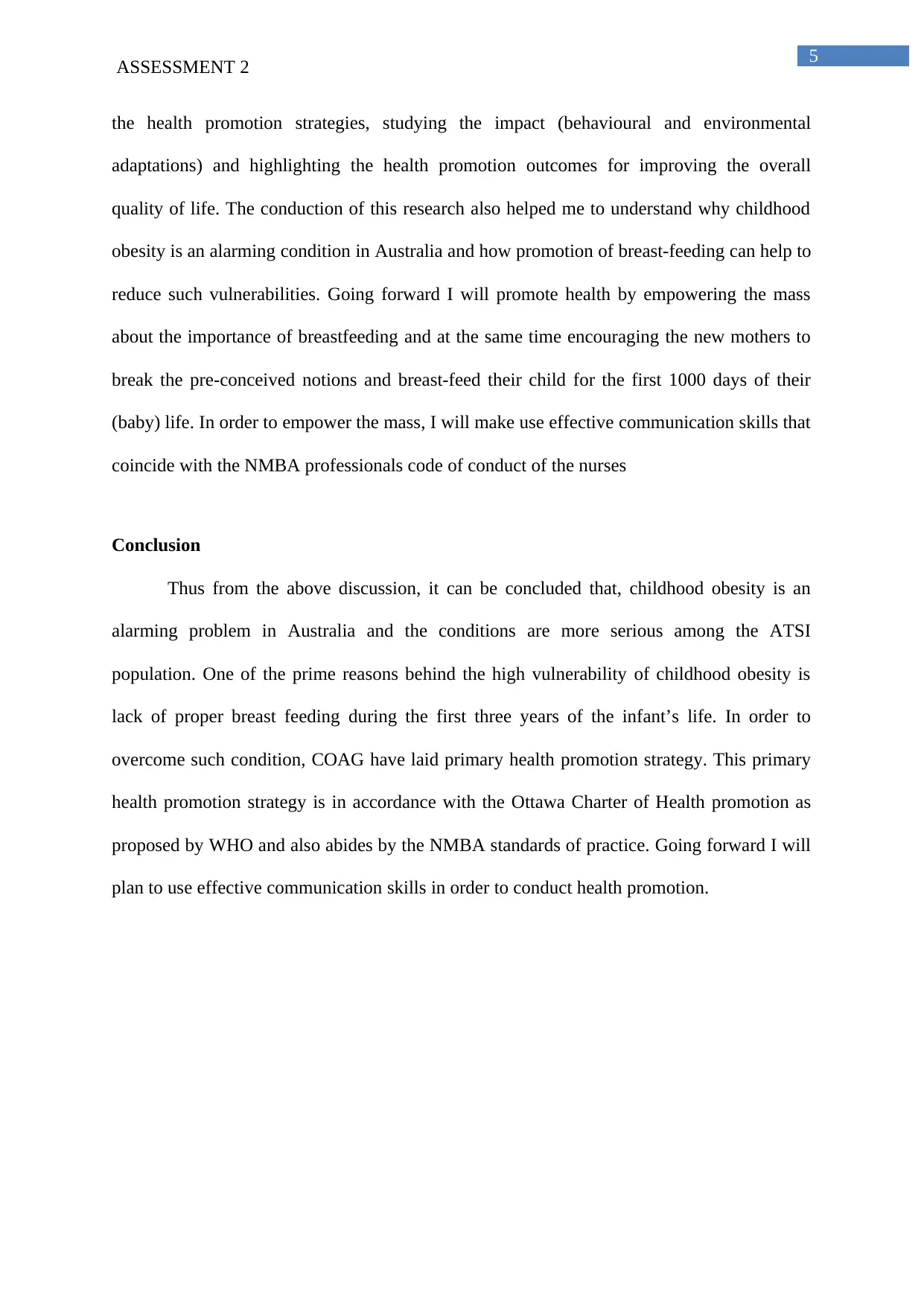
5
ASSESSMENT 2
the health promotion strategies, studying the impact (behavioural and environmental
adaptations) and highlighting the health promotion outcomes for improving the overall
quality of life. The conduction of this research also helped me to understand why childhood
obesity is an alarming condition in Australia and how promotion of breast-feeding can help to
reduce such vulnerabilities. Going forward I will promote health by empowering the mass
about the importance of breastfeeding and at the same time encouraging the new mothers to
break the pre-conceived notions and breast-feed their child for the first 1000 days of their
(baby) life. In order to empower the mass, I will make use effective communication skills that
coincide with the NMBA professionals code of conduct of the nurses
Conclusion
Thus from the above discussion, it can be concluded that, childhood obesity is an
alarming problem in Australia and the conditions are more serious among the ATSI
population. One of the prime reasons behind the high vulnerability of childhood obesity is
lack of proper breast feeding during the first three years of the infant’s life. In order to
overcome such condition, COAG have laid primary health promotion strategy. This primary
health promotion strategy is in accordance with the Ottawa Charter of Health promotion as
proposed by WHO and also abides by the NMBA standards of practice. Going forward I will
plan to use effective communication skills in order to conduct health promotion.
ASSESSMENT 2
the health promotion strategies, studying the impact (behavioural and environmental
adaptations) and highlighting the health promotion outcomes for improving the overall
quality of life. The conduction of this research also helped me to understand why childhood
obesity is an alarming condition in Australia and how promotion of breast-feeding can help to
reduce such vulnerabilities. Going forward I will promote health by empowering the mass
about the importance of breastfeeding and at the same time encouraging the new mothers to
break the pre-conceived notions and breast-feed their child for the first 1000 days of their
(baby) life. In order to empower the mass, I will make use effective communication skills that
coincide with the NMBA professionals code of conduct of the nurses
Conclusion
Thus from the above discussion, it can be concluded that, childhood obesity is an
alarming problem in Australia and the conditions are more serious among the ATSI
population. One of the prime reasons behind the high vulnerability of childhood obesity is
lack of proper breast feeding during the first three years of the infant’s life. In order to
overcome such condition, COAG have laid primary health promotion strategy. This primary
health promotion strategy is in accordance with the Ottawa Charter of Health promotion as
proposed by WHO and also abides by the NMBA standards of practice. Going forward I will
plan to use effective communication skills in order to conduct health promotion.
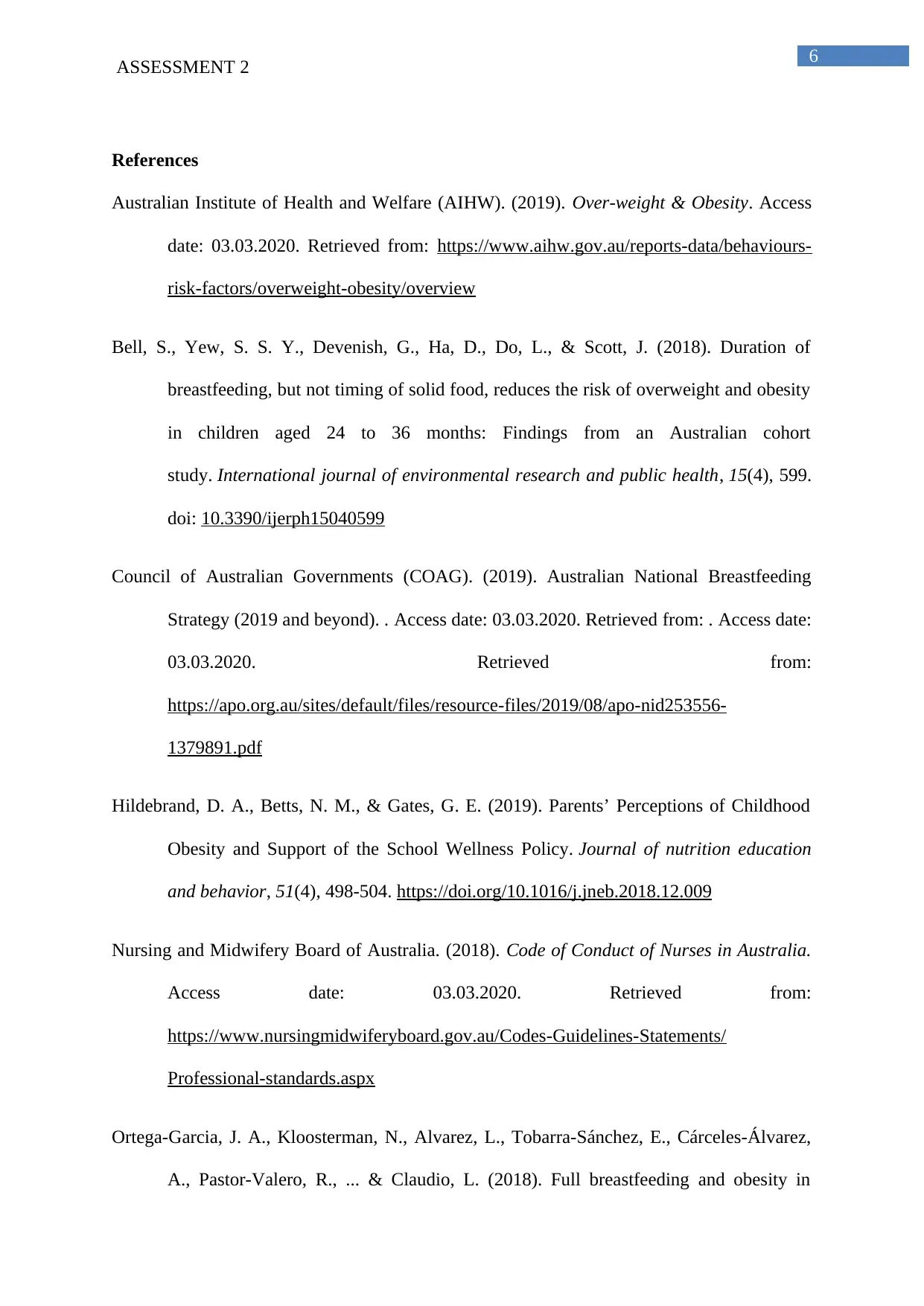
6
ASSESSMENT 2
References
Australian Institute of Health and Welfare (AIHW). (2019). Over-weight & Obesity. Access
date: 03.03.2020. Retrieved from: https://www.aihw.gov.au/reports-data/behaviours-
risk-factors/overweight-obesity/overview
Bell, S., Yew, S. S. Y., Devenish, G., Ha, D., Do, L., & Scott, J. (2018). Duration of
breastfeeding, but not timing of solid food, reduces the risk of overweight and obesity
in children aged 24 to 36 months: Findings from an Australian cohort
study. International journal of environmental research and public health, 15(4), 599.
doi: 10.3390/ijerph15040599
Council of Australian Governments (COAG). (2019). Australian National Breastfeeding
Strategy (2019 and beyond). . Access date: 03.03.2020. Retrieved from: . Access date:
03.03.2020. Retrieved from:
https://apo.org.au/sites/default/files/resource-files/2019/08/apo-nid253556-
1379891.pdf
Hildebrand, D. A., Betts, N. M., & Gates, G. E. (2019). Parents’ Perceptions of Childhood
Obesity and Support of the School Wellness Policy. Journal of nutrition education
and behavior, 51(4), 498-504. https://doi.org/10.1016/j.jneb.2018.12.009
Nursing and Midwifery Board of Australia. (2018). Code of Conduct of Nurses in Australia.
Access date: 03.03.2020. Retrieved from:
https://www.nursingmidwiferyboard.gov.au/Codes-Guidelines-Statements/
Professional-standards.aspx
Ortega-Garcia, J. A., Kloosterman, N., Alvarez, L., Tobarra-Sánchez, E., Cárceles-Álvarez,
A., Pastor-Valero, R., ... & Claudio, L. (2018). Full breastfeeding and obesity in
ASSESSMENT 2
References
Australian Institute of Health and Welfare (AIHW). (2019). Over-weight & Obesity. Access
date: 03.03.2020. Retrieved from: https://www.aihw.gov.au/reports-data/behaviours-
risk-factors/overweight-obesity/overview
Bell, S., Yew, S. S. Y., Devenish, G., Ha, D., Do, L., & Scott, J. (2018). Duration of
breastfeeding, but not timing of solid food, reduces the risk of overweight and obesity
in children aged 24 to 36 months: Findings from an Australian cohort
study. International journal of environmental research and public health, 15(4), 599.
doi: 10.3390/ijerph15040599
Council of Australian Governments (COAG). (2019). Australian National Breastfeeding
Strategy (2019 and beyond). . Access date: 03.03.2020. Retrieved from: . Access date:
03.03.2020. Retrieved from:
https://apo.org.au/sites/default/files/resource-files/2019/08/apo-nid253556-
1379891.pdf
Hildebrand, D. A., Betts, N. M., & Gates, G. E. (2019). Parents’ Perceptions of Childhood
Obesity and Support of the School Wellness Policy. Journal of nutrition education
and behavior, 51(4), 498-504. https://doi.org/10.1016/j.jneb.2018.12.009
Nursing and Midwifery Board of Australia. (2018). Code of Conduct of Nurses in Australia.
Access date: 03.03.2020. Retrieved from:
https://www.nursingmidwiferyboard.gov.au/Codes-Guidelines-Statements/
Professional-standards.aspx
Ortega-Garcia, J. A., Kloosterman, N., Alvarez, L., Tobarra-Sánchez, E., Cárceles-Álvarez,
A., Pastor-Valero, R., ... & Claudio, L. (2018). Full breastfeeding and obesity in
Paraphrase This Document
Need a fresh take? Get an instant paraphrase of this document with our AI Paraphraser
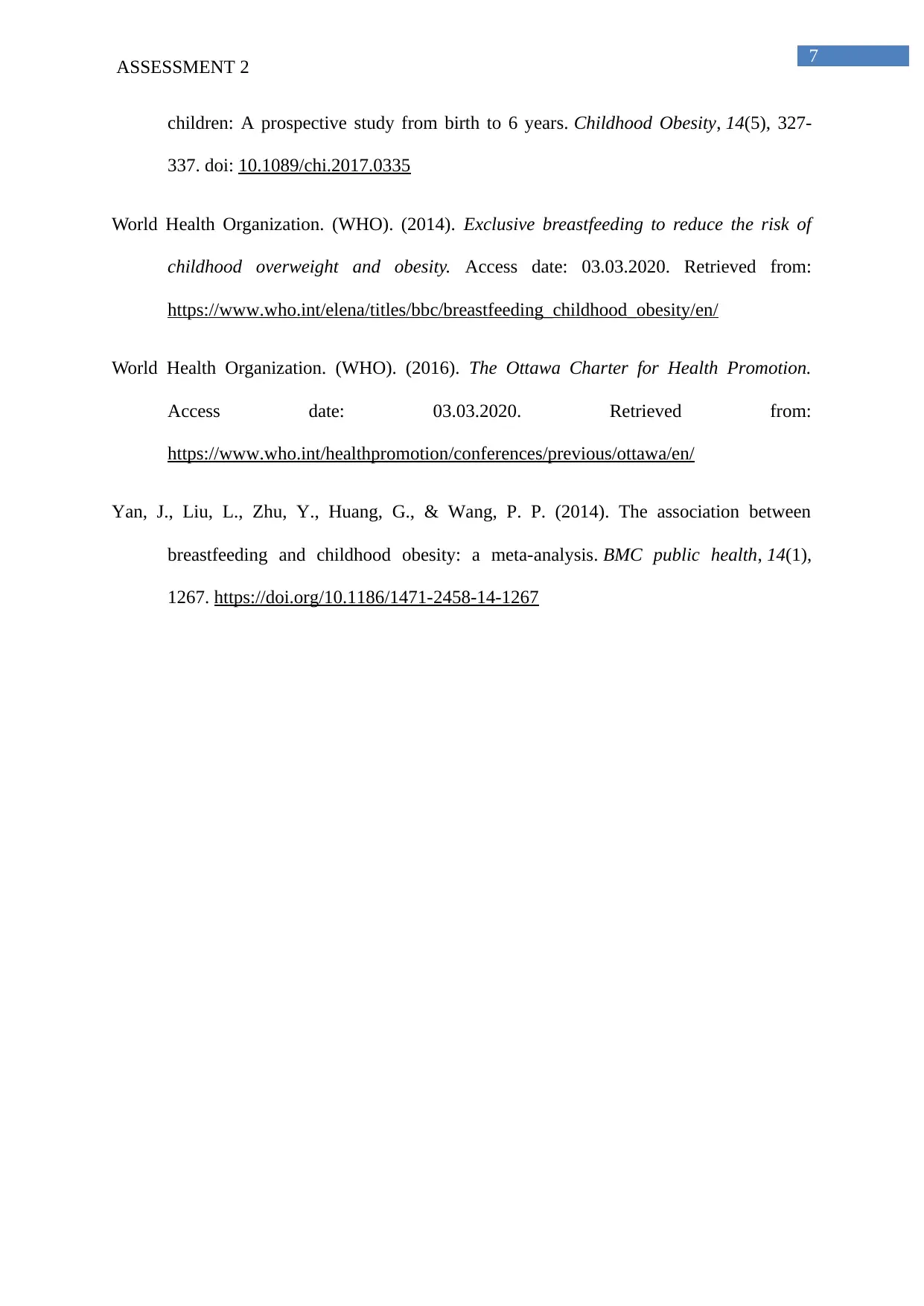
7
ASSESSMENT 2
children: A prospective study from birth to 6 years. Childhood Obesity, 14(5), 327-
337. doi: 10.1089/chi.2017.0335
World Health Organization. (WHO). (2014). Exclusive breastfeeding to reduce the risk of
childhood overweight and obesity. Access date: 03.03.2020. Retrieved from:
https://www.who.int/elena/titles/bbc/breastfeeding_childhood_obesity/en/
World Health Organization. (WHO). (2016). The Ottawa Charter for Health Promotion.
Access date: 03.03.2020. Retrieved from:
https://www.who.int/healthpromotion/conferences/previous/ottawa/en/
Yan, J., Liu, L., Zhu, Y., Huang, G., & Wang, P. P. (2014). The association between
breastfeeding and childhood obesity: a meta-analysis. BMC public health, 14(1),
1267. https://doi.org/10.1186/1471-2458-14-1267
ASSESSMENT 2
children: A prospective study from birth to 6 years. Childhood Obesity, 14(5), 327-
337. doi: 10.1089/chi.2017.0335
World Health Organization. (WHO). (2014). Exclusive breastfeeding to reduce the risk of
childhood overweight and obesity. Access date: 03.03.2020. Retrieved from:
https://www.who.int/elena/titles/bbc/breastfeeding_childhood_obesity/en/
World Health Organization. (WHO). (2016). The Ottawa Charter for Health Promotion.
Access date: 03.03.2020. Retrieved from:
https://www.who.int/healthpromotion/conferences/previous/ottawa/en/
Yan, J., Liu, L., Zhu, Y., Huang, G., & Wang, P. P. (2014). The association between
breastfeeding and childhood obesity: a meta-analysis. BMC public health, 14(1),
1267. https://doi.org/10.1186/1471-2458-14-1267
1 out of 8
Related Documents
Your All-in-One AI-Powered Toolkit for Academic Success.
+13062052269
info@desklib.com
Available 24*7 on WhatsApp / Email
![[object Object]](/_next/static/media/star-bottom.7253800d.svg)
Unlock your academic potential
© 2024 | Zucol Services PVT LTD | All rights reserved.




